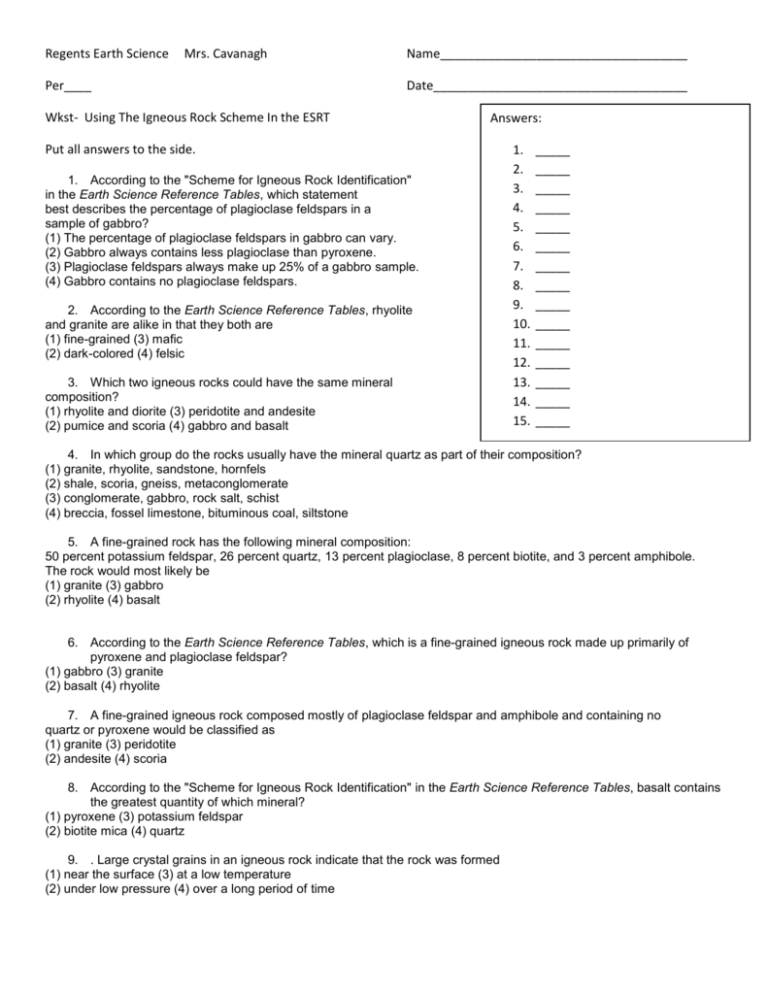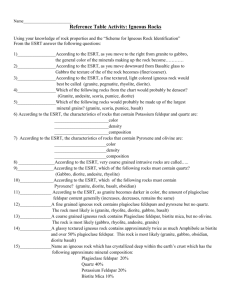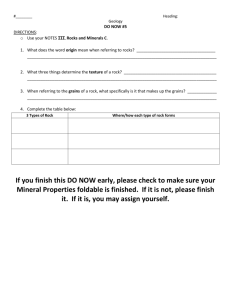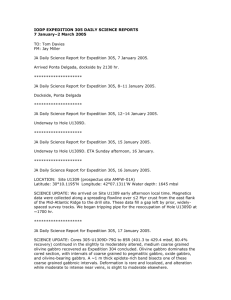Wkst- Igneous Rock
advertisement

Regents Earth Science Mrs. Cavanagh Per____ Name____________________________________ Date_____________________________________ Wkst- Using The Igneous Rock Scheme In the ESRT Answers: Put all answers to the side. 1. According to the "Scheme for Igneous Rock Identification" in the Earth Science Reference Tables, which statement best describes the percentage of plagioclase feldspars in a sample of gabbro? (1) The percentage of plagioclase feldspars in gabbro can vary. (2) Gabbro always contains less plagioclase than pyroxene. (3) Plagioclase feldspars always make up 25% of a gabbro sample. (4) Gabbro contains no plagioclase feldspars. 2. According to the Earth Science Reference Tables, rhyolite and granite are alike in that they both are (1) fine-grained (3) mafic (2) dark-colored (4) felsic 3. Which two igneous rocks could have the same mineral composition? (1) rhyolite and diorite (3) peridotite and andesite (2) pumice and scoria (4) gabbro and basalt 1. 2. 3. 4. 5. 6. 7. 8. 9. 10. 11. 12. 13. 14. 15. _____ _____ _____ _____ _____ _____ _____ _____ _____ _____ _____ _____ _____ _____ _____ 4. In which group do the rocks usually have the mineral quartz as part of their composition? (1) granite, rhyolite, sandstone, hornfels (2) shale, scoria, gneiss, metaconglomerate (3) conglomerate, gabbro, rock salt, schist (4) breccia, fossel limestone, bituminous coal, siltstone 5. A fine-grained rock has the following mineral composition: 50 percent potassium feldspar, 26 percent quartz, 13 percent plagioclase, 8 percent biotite, and 3 percent amphibole. The rock would most likely be (1) granite (3) gabbro (2) rhyolite (4) basalt 6. According to the Earth Science Reference Tables, which is a fine-grained igneous rock made up primarily of pyroxene and plagioclase feldspar? (1) gabbro (3) granite (2) basalt (4) rhyolite 7. A fine-grained igneous rock composed mostly of plagioclase feldspar and amphibole and containing no quartz or pyroxene would be classified as (1) granite (3) peridotite (2) andesite (4) scoria 8. According to the "Scheme for Igneous Rock Identification" in the Earth Science Reference Tables, basalt contains the greatest quantity of which mineral? (1) pyroxene (3) potassium feldspar (2) biotite mica (4) quartz 9. . Large crystal grains in an igneous rock indicate that the rock was formed (1) near the surface (3) at a low temperature (2) under low pressure (4) over a long period of time 10. According to the Scheme for Igneous Rock Identification, compared to basalt, granite is (1) lighter in color (2) greater in density (3) more mafic in composition (4) more fine grained in texture 11. Large crystals in an igneous rock most likely form as a result of the (1) mineral composition of the magma (2) cooling rate of the magma (3) fossil content of the rock (4) color of the rock 12.Olivine and pyroxene are commonly found in igneous rocks that are (1) felsic, with low density (3) mafic, with low density (2) felsic, with high density (4) mafic, with high density 13. According to the Earth Science Reference Tables, which statement is true of granite and gabbro? (1) are both intrusive (2) are both extrusive (3) have different grain sizes (4) both contain potassium feldspar 14.The diagram below shows the mineral composition of an igneous rock drawn actual size. [hornblende =amphibole[ According to the Earth Science Reference Tables, this igneous rock is (1) gabbro (3) basalt (2) granite (4) rhyolite 15.Which characteristic provides the best evidence that obsidian rock formed in an extrusive environment? (1) layers of rounded fragments (2) distorted bands of large mineral crystals (3) noncrystalline glassy texture (4) mineral cement between grains






